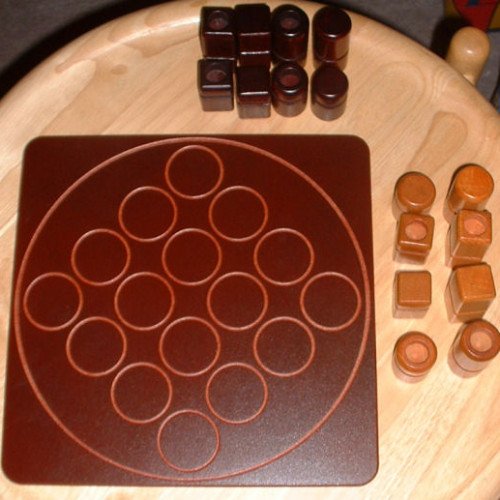QUARTO VS TABLUT

QUARTO
Quarto is a board game for two players invented by Swiss mathematician Blaise Müller. It is published and copyrighted by Gigamic. The game is played on a 4×4 board. There are 16 unique pieces to play with, each of which is either: tall or short; red or blue (or a different pair of colors, e.g. light- or dark-stained wood); square or circular; and hollow-top or solid-top. Players take turns choosing a piece which the other player must then place on the board. A player wins by placing a piece on the board which forms a horizontal, vertical, or diagonal row of four pieces, all of which have a common attribute (all short, all circular, etc.). A variant rule included in many editions gives a second way to win by placing four matching pieces in a 2×2 square. Quarto is distinctive in that there is only one set of common pieces, rather than a set for one player and a different set for the other. It is therefore an impartial game.
Statistics for this Xoptio

TABLUT
Tafl games (pronounced ], also known as hnefatafl games) are a family of ancient Nordic and Celtic strategy board games played on a checkered or latticed gameboard with two armies of uneven numbers. Most probably they are based upon the Roman game Ludus latrunculorum. Names of different variants of Tafl include Hnefatafl, Tablut, Tawlbwrdd, Brandubh, Ard Rí, and Alea Evangelii. Games in the tafl family were played in Norway, Sweden, Denmark, Iceland, Britain, Ireland, and Lapland. Tafl gaming was eventually supplanted by chess in the 12th Century, but the tafl variant of the Sami people, tablut, was in play until at least the 1700s. The rules for tablut were written down by the Swedish naturalist Linnaeus in 1732, and these were translated from Latin to English in 1811. All modern tafl games are based on the 1811 translation, which had many errors. New rules were added to amend the issues resulting from these errors, leading to the creation of a modern family of tafl games. In addition, tablut is now also played in accordance with its original rules, which have been retranslated. The term tafl (Old Norse: "table", "board"; pronounced ) is the original Norse name of the game. Hnefatafl (roughly) plausibly realised as ), became the preferred term for the game in Scandinavia by the end of the Viking Age, to distinguish it from other board games, such as Skáktafl (chess), Kvatrutafl (Tables) and Halatafl (Fox games), as these became known. The specific name Hnefatafl possibly arose as meaning "board game of the fist", from hnefi ("fist") + tafl, where "fist" referred to the central king-piece. The precise etymology is not entirely certain but hnefi certainly referred to the king-piece, and several sources refer to Hnefatafl as "King's table". In Anglo-Saxon England, the term tæfl also referred to many board games. It is not known if the Anglo-Saxons had a specific name for the game or if they generically referred to it as tæfl in the way that modern people might refer to "cards". Several games may be confused with tafl games, due to the inclusion of the word tafl in their names or other similarities. Halatafl is the Old Norse name for Fox and Geese, a game dating from at least the 14th century. It is still known and played in Europe. Kvatrutafl is the Old Norse name for Tables (the medieval forerunner of Backgammon). Skáktafl is the Old Norse name for chess. Fidchell or Fithcheall (Modern Irish: Ficheall) was played in Ireland. The Welsh equivalent was Gwyddbwyll and the Breton equivalent Gwezboell; all terms mean "wood-sense". This popular medieval game was played with equal forces on each side and thus was not a tafl variant, but rather may have been the medieval descendant of the Roman game Latrunculi or Ludus latrunculorum.